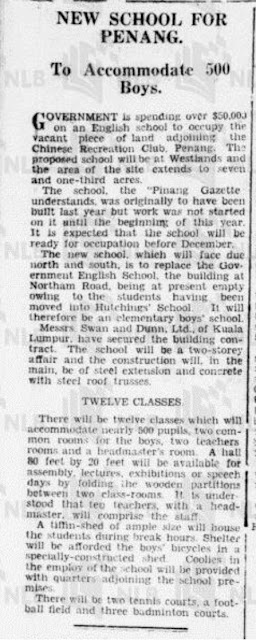
IT IS often said that our schooldays are the most carefree days of our lives. While we may not have been aware of it at the time, those carefree days were, however, a significant influence on shaping our young lives. Beyond the school gates, history-making events in the wider world were also leaving their mark, on top of our personal experiences at Westlands.
This is a journey back in time to our Westlands years from 1960 to 1965.
1960
- The Malayan Emergency (1948-1960) ended on 31 July 1960 when the Malayan government declared the state of emergency was over.
- Russia shot down an American U2 spy plane. Its pilot, Francis Gary Powers, was detained for two years.
- John F Kennedy became the President of the United States.
- Radio RAAF Butterworth was established.
- The movies we saw: GI blues (Elvis Presley), Swiss family Robinson, Spartacus (Kirk Douglas).
- The songs we listened to: Oh! Carol (Neil Sedaka), The twist (Chubby Checker), It's now or never (Elvis Presley), Only the lonely (Roy Orbison).

1961
- Tunku Abdul Rahman proposed the concept of a “Mighty Malaysia" consisting of Malaya, Singapore, North Borneo, Brunei and Sarawak.
- Yuri Gagarin became the first man to orbit the Earth.
- On 13 August 1961, construction of the Berlin Wall began, cutting off West Berlin from all of surrounding East Germany and East Berlin.
- The movies we saw: Blue Hawaii (Elvis Presley), Guns of Navarone.
- The songs we listened to: Runaway (Del Shannon ), Travelin’ man (Ricky Nelson), Tonight my love, tonight (Paul Anka).

1962
- Detection of Soviet nuclear missiles in Cuba by American spy planes led to the Cuban missile crisis, a tense standoff between the two major Cold War nuclear powers.
- Marilyn Monroe, 36, was found dead in her bedroom.
- Sonny Liston defeated Floyd Patterson to become world heavyweight champion.
- The movies we saw: Dr No (first James Bond film), Lawrence of Arabia (Peter O'Toole), The Longest Day.
- The songs we listened to: Limbo rock (Chubby Checker), Speedy Gonzales (Pat Boone), Love me do (Beatles, debut single), Stranger on the shore (Acker Bilk), Roses are red (Bobby Vinton), The man who shot Liberty Valance (Gene Pitney).
1963
- The Federation of Malaysia was declared on 16 September 1963 with the merging of Malaya, Singapore, Sabah and Sarawak.
- Indonesian opposition to the formation of Malaysia resulted in Konfrontasi, the Indonesian-Malaysian confrontation that was an armed conflict but undeclared war.
- With the background of increasing guerrilla insurgency in South Vietnam, President Ngô Đình Diệm was overthrown and executed, along with his brother, on 2 November 1963.
- President John F Kennedy was assassinated in Dallas, Texas on 22 November 1963.
- Television Malaysia began broadcasting in black and white.
- The movies we saw: From Russia with love, The birds (Alfred Hitchcock), Summer holiday (Cliff Richard).
- The songs we listened to: I want to hold your hand (Beatles), Oh Malaysia (Anneke Grönloh), Sukiyaki (Kyu Sakamoto), Puff the magic dragon (Peter, Paul and Mary).
1964
- The Games of the XVIII Olympiad were held in Tokyo.
- In August 1964, the USS Maddox was involved in the Gulf of Tonkin incident, which led to an escalation of the Vietnam War and US involvement.
- Lin Dai committed suicide.
- Cassius Clay defeated Sonny Liston in a technical knockout to become the world heavyweight champion.
- The movies we saw: A hard day’s night (Beatles), Goldfinger, My fair lady (Audrey Hepburn and Rex Harrison), Mary Poppins (Julie Andrews).
- The songs we listened to: A hard day’s night, She loves you (Beatles), Hello, Dolly! (Louis Armstrong), Under the boardwalk (Drifters), Wishin' and hopin' (Dusty Springfield).
1965
- The American ground war in Vietnam started, together with the massive bombing campaign.
- Singapore was expelled from Malaysia, and became an independent nation.
- President Sukarno was deposed after an attempted coup, and control of Indonesia was transferred to General Suharto and the military.
- Muhammad Ali (who had changed his name from Cassius Clay) knocked out Sonny Liston in the first round of a rematch.
- The movies we saw: The sound of music (Julie Andrews), Doctor Zhivago (Omar Sharif).
- The songs we listened to: Yesterday (Beatles, a track on their Help! album), Satisfaction (Rolling Stones), Downtown (Petula Clark), Ferry cross the Mersey (Gerry and the Pacemakers).
-- Yeo Guan Khim --

















